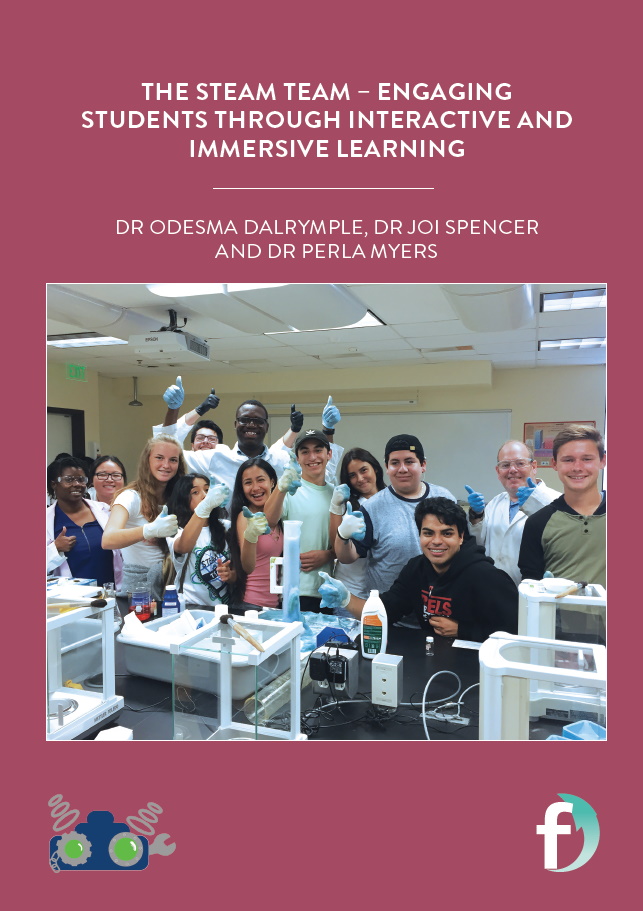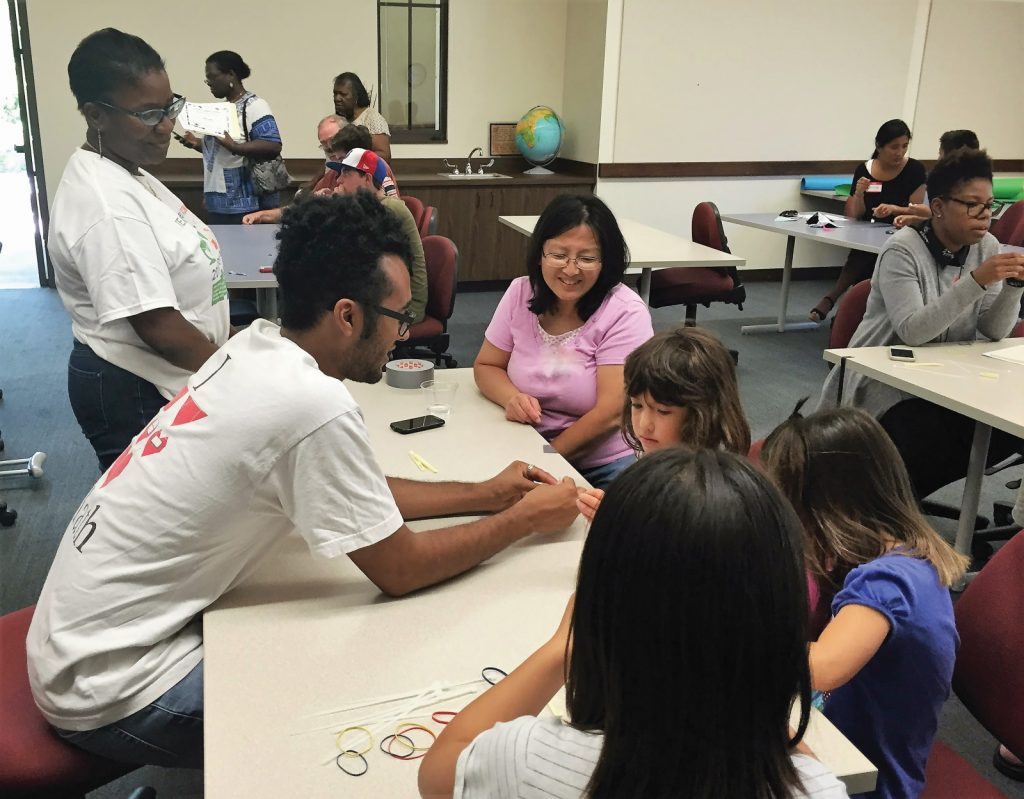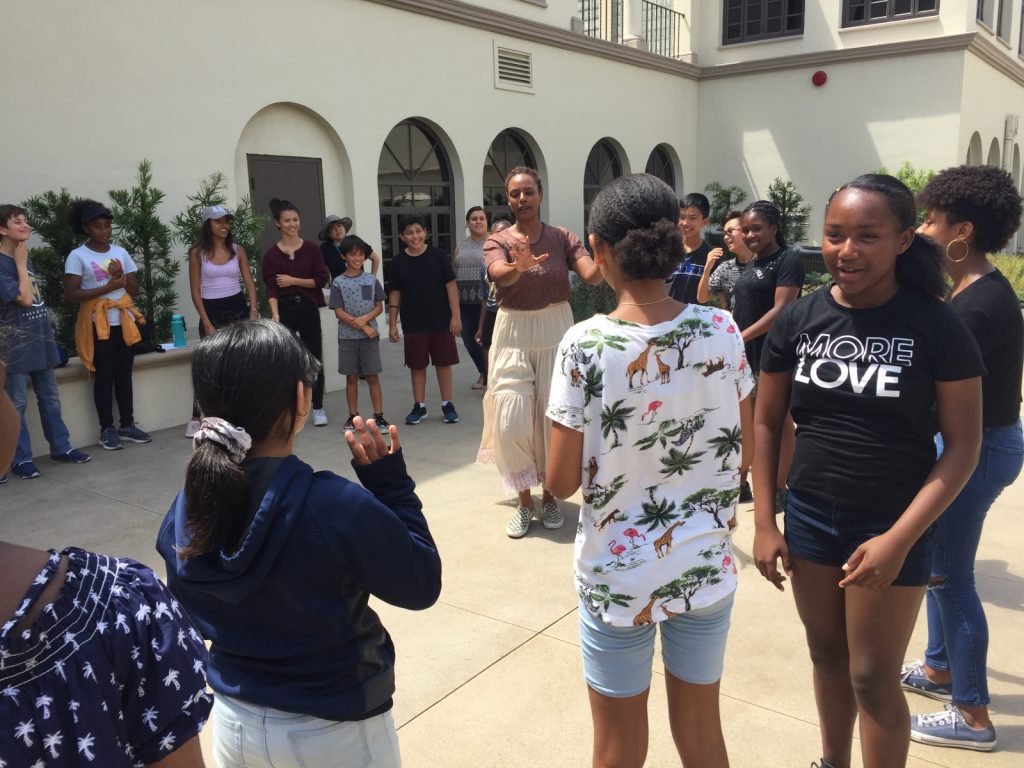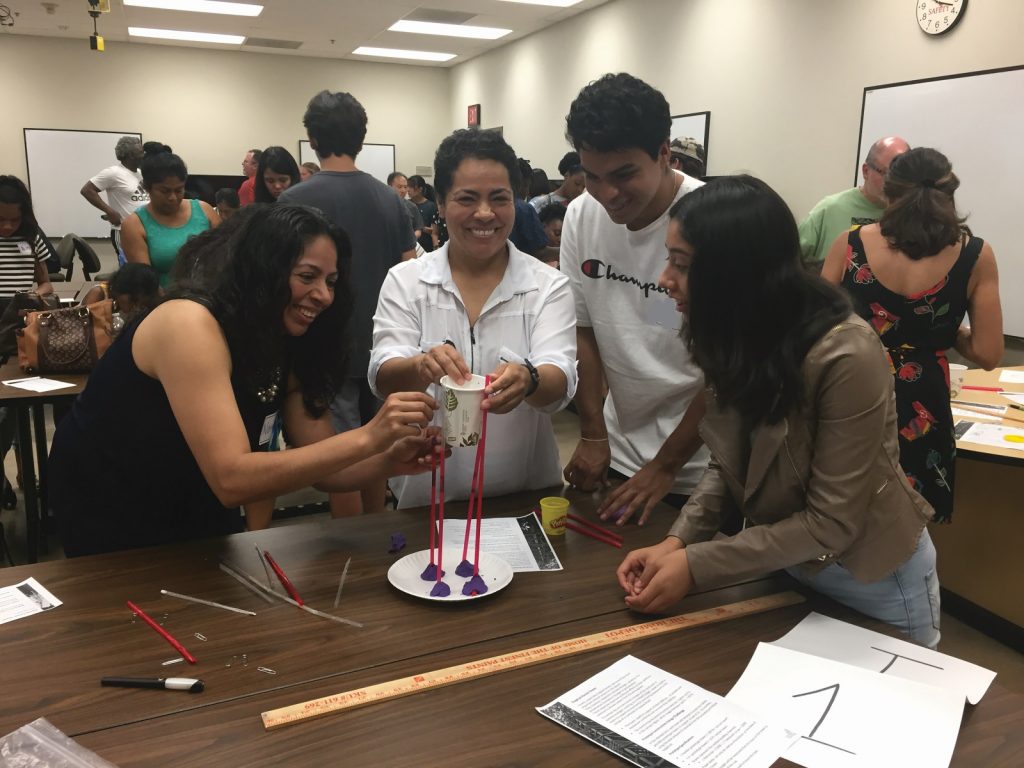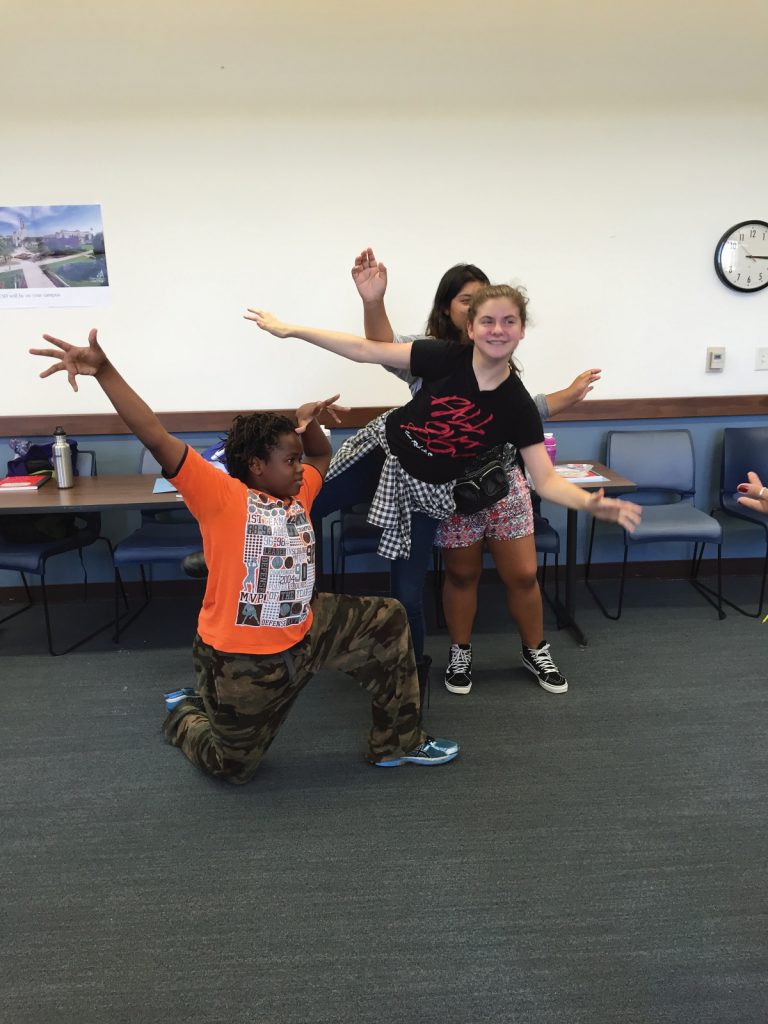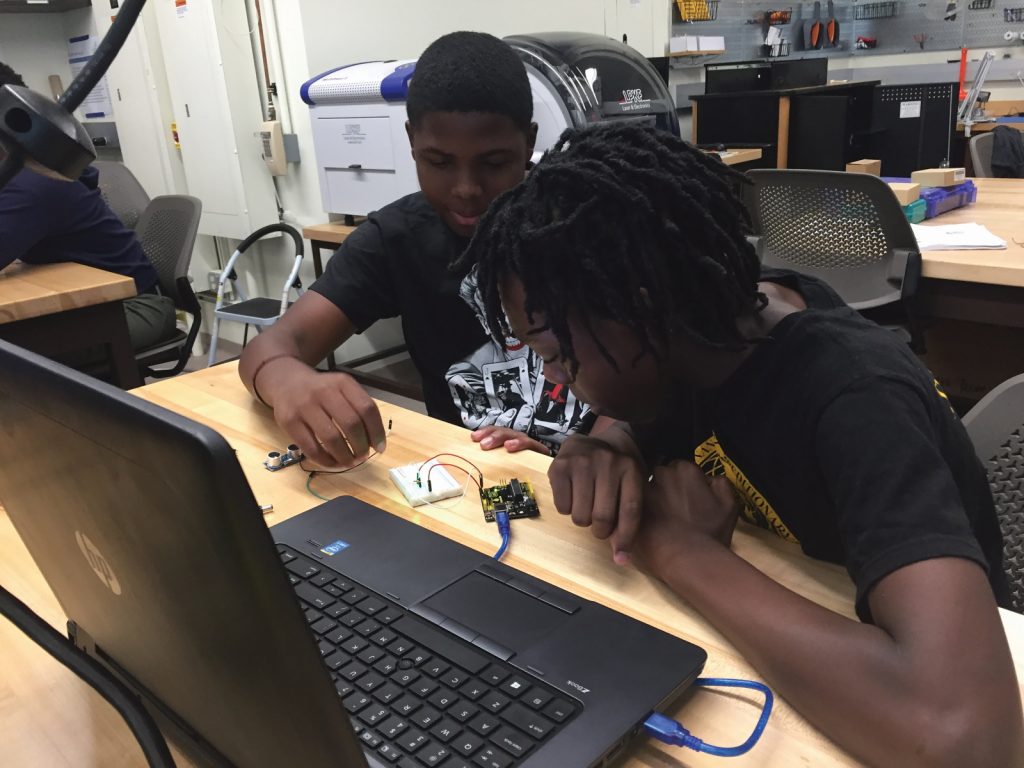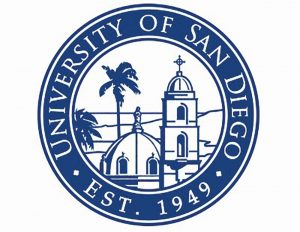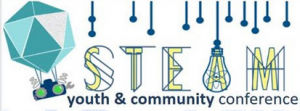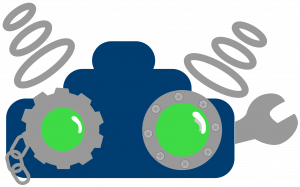The STEAM Team – engaging students through interactive and immersive learning
The STEAM Team Academy, the hugely successful brainchild of Dr Odesma Dalrymple, Dr Joi Spencer and Dr Perla Myers of the University of San Diego, USA, highlights the importance of hands-on, community based learning in allowing students to connect concepts from STEAM to every aspect of their lives
All too often, we consider individual subjects as isolated. Mathematics teachers teach mathematics in classrooms, chemistry teachers teach chemistry in labs, and PE teachers teach sports on the playing field. In school settings, timetable allocations can suggest all subjects are distinct but, in reality, every subject is connected and it is essential students know this if they are to appreciate the interdisciplinary nature of life.
To address this, Dr Odesma Dalrymple, Dr Joi Spencer and Dr Perla Myers of the University of San Diego established the STEAM (Science, Technology, Engineering, Arts, Mathematics) Team Academy, a week-long summer programme providing middle and high school students with the opportunity to engage in hands-on learning. “We wanted to create a STEAM program that is fun, engaging and challenging, providing opportunities for growth and development through productive struggles,” says Odesma.
Complementing the STEAM Team Academy, they also run the STEAM Youth and Community Conference, to which students’ families, local educators and community members are also invited. “Learning is a social endeavor heavily influenced by the environment in which the learning occurs” explains Joi, which is why it is crucial to engage the whole community in this effort. “Since our focus is on informal learning, we want to facilitate STEAM learning even after students have left the Academy.”
Odesma, Joi and Perla specifically focus on raising the STEAM literacy of students and increasing their ability to see STEAM as an integral part of their everyday lives.
WHAT IS STEAM LITERACY?
In a broad sense, the term STEAM covers science, technology, engineering, arts and mathematics. But to be ‘STEAM literate’ does not mean that you must excel in every subject. Instead, it requires transferable skills, independent of any one specific domain of subject knowledge.
“This includes an ability to observe carefully and be curious,” explains Perla, “to ask questions, especially ones you can’t immediately answer. And to embrace failure and productive struggle as necessary steps along the path, as they are part of the learning process.” It includes critical thinking and the capacity to understand data presented in various forms. The ability to communicate ideas, through oral stories or drawings, written narratives or movies, is equally important. “We must be empathetic,” says Odesma, “understanding the human element in STEAM and the ways in which our society shapes, and is shaped by, STEAM.”
COMMUNITY ENGAGEMENT
Most students who attend the STEAM Team Academy come from communities that are underrepresented in STEM professions. But these communities contain a wealth of knowledge that can be utilised to ignite the spark for continued learning. “We seek ways to engage in explorations of the many assets within these communities,” says Joi.
As rich sources of wisdom and practical knowledge, the communities themselves provide “a starting point for conversations about equity, advocacy and the importance of standing up for social justice and making change,” explains Perla. And by using the students’ own communities as a learning resource, not only do students feel that this education is relevant to their own lived experiences, but they can appreciate how all aspects of their lives are underlain by STEAM concepts.
A visit to Chicano Park provides an opportunity to learn from the community. Situated below a freeway junction in a predominantly Mexican neighbourhood of San Diego, the park is home to the country’s largest collection of outdoor murals. Academy students immerse themselves within this national treasure, experiencing history, marginalisation and inequities with all their senses. They meet artists who work in the park and hear how they create murals on the arches of the very highway that fragments and pollutes their community, and understand how art can be a vehicle for getting their voices heard.
“We have talked to a mural artist who advocates with his art,” says Odesma. “It was wonderful for students to hear how he uses mathematics to create art.” Like many of the students, the artist did not initially consider his work to be mathematical. Yet, the ability to scale a plan from a small piece of paper to the size of a large mural and represent three-dimensional shapes in two dimensions show how mathematics and art are interrelated. “There is so much mathematical richness embedded in the art he has developed and perfected throughout his life.”
Rather than feeling that ‘STEAM’ represents subjects they must study, the Academy teaches how STEAM can answer questions significant to students’ lives. “We want students to appreciate that all the practices they engage in are also examples of STEAM activities,” explains Joi. “These activities are just as important as the STEAM subjects they learn in school.”
UN DEVELOPMENT GOALS
Many discussions at the Academy are based around the United Nations’ Sustainable Development Goals, particularly focusing on reducing inequities, which enables students to see themselves in the larger context of global citizenship. “When students read these goals, they see that others around the world are grappling with the same challenges that we face in the US,” explains Joi. They also highlight the huge inequalities that still exist. “Students are surprised that there are still places where girls cannot go to school, or where basic medical care is not available.”
“The Sustainable Development Goals are an opportunity to recognize our collective responsibilities as citizens of the world,” says Joi. “Most importantly, students see how STEAM skills can be applied to the world’s most challenging dilemmas. Gaining STEAM skills is no longer about getting a high paying job, but about addressing these problems. We believe that STEAM should be of service to humanity. That is the message we want our participants to come away with.”
To highlight the concept of inequity, students play Inequity Monopoly, where each player has a different set of rules. Some receive $200 when they pass Go, others do not. Property prices are different for each player. Some can purchase certain properties, others cannot. “At some point in the game, the rules become ‘fair’ again and we continue playing,” says Joi, “but those who had an advantageous start are so far ahead that it’s impossible for those who are behind to catch up. We have important conversations about real-life examples of this, and the implications of these situations.”
SUCCESS
Since its creation in 2015, the STEAM Team Academy has continued to grow. Many students return year after year, proof that this is an enjoyable setting in which to learn. And many students who pass through the Academy return as enrichment facilitators, now leading the activities they once participated in. Sharing the same background as the facilitators allows current students to identify with their near-peer mentors. Former students act as role models, inspiring the next generation to engage in STEAM.
“We witness our students’ growth and maturation,” says Perla. “We see our model of peer mentorship and community immersion actualized in the lives of our students, many of whom are now pursuing STEM majors in college.” “Recently a former student wrote to us, sharing the impact of the program on her first year of college,” says Odesma. “She explained how the idea of Productive Struggle (a concept that we emphasize throughout STEAM Team Academy) helped her in overcoming the difficulties she faced in her STEAM courses. Instead of seeing the challenges as a sign of failure, she was able to see academic struggle as a springboard for deeper thinking and reflection.”
“Our belief is that students have a natural desire to learn. When work is engaging, interest is sustained and deepened,” says Joi. “We have seen our students accomplish amazing things.”
Reference
https://doi.org/10.33424/FUTURUM211
To address this, Dr Odesma Dalrymple, Dr Joi Spencer and Dr Perla Myers of the University of San Diego established the STEAM (Science, Technology, Engineering, Arts, Mathematics) Team Academy, a week-long summer programme providing middle and high school students with the opportunity to engage in hands-on learning. “We wanted to create a STEAM program that is fun, engaging and challenging, providing opportunities for growth and development through productive struggles,” says Odesma.
Complementing the STEAM Team Academy, they also run the STEAM Youth and Community Conference, to which students’ families, local educators and community members are also invited. “Learning is a social endeavor heavily influenced by the environment in which the learning occurs” explains Joi, which is why it is crucial to engage the whole community in this effort. “Since our focus is on informal learning, we want to facilitate STEAM learning even after students have left the Academy.”
Odesma, Joi and Perla specifically focus on raising the STEAM literacy of students and increasing their ability to see STEAM as an integral part of their everyday lives.
WHAT IS STEAM LITERACY?
In a broad sense, the term STEAM covers science, technology, engineering, arts and mathematics. But to be ‘STEAM literate’ does not mean that you must excel in every subject. Instead, it requires transferable skills, independent of any one specific domain of subject knowledge.
“This includes an ability to observe carefully and be curious,” explains Perla, “to ask questions, especially ones you can’t immediately answer. And to embrace failure and productive struggle as necessary steps along the path, as they are part of the learning process.” It includes critical thinking and the capacity to understand data presented in various forms. The ability to communicate ideas, through oral stories or drawings, written narratives or movies, is equally important. “We must be empathetic,” says Odesma, “understanding the human element in STEAM and the ways in which our society shapes, and is shaped by, STEAM.”
COMMUNITY ENGAGEMENT
Most students who attend the STEAM Team Academy come from communities that are underrepresented in STEM professions. But these communities contain a wealth of knowledge that can be utilised to ignite the spark for continued learning. “We seek ways to engage in explorations of the many assets within these communities,” says Joi.
As rich sources of wisdom and practical knowledge, the communities themselves provide “a starting point for conversations about equity, advocacy and the importance of standing up for social justice and making change,” explains Perla. And by using the students’ own communities as a learning resource, not only do students feel that this education is relevant to their own lived experiences, but they can appreciate how all aspects of their lives are underlain by STEAM concepts.
A visit to Chicano Park provides an opportunity to learn from the community. Situated below a freeway junction in a predominantly Mexican neighbourhood of San Diego, the park is home to the country’s largest collection of outdoor murals. Academy students immerse themselves within this national treasure, experiencing history, marginalisation and inequities with all their senses. They meet artists who work in the park and hear how they create murals on the arches of the very highway that fragments and pollutes their community, and understand how art can be a vehicle for getting their voices heard.
“We have talked to a mural artist who advocates with his art,” says Odesma. “It was wonderful for students to hear how he uses mathematics to create art.” Like many of the students, the artist did not initially consider his work to be mathematical. Yet, the ability to scale a plan from a small piece of paper to the size of a large mural and represent three-dimensional shapes in two dimensions show how mathematics and art are interrelated. “There is so much mathematical richness embedded in the art he has developed and perfected throughout his life.”
Rather than feeling that ‘STEAM’ represents subjects they must study, the Academy teaches how STEAM can answer questions significant to students’ lives. “We want students to appreciate that all the practices they engage in are also examples of STEAM activities,” explains Joi. “These activities are just as important as the STEAM subjects they learn in school.”
UN DEVELOPMENT GOALS
Many discussions at the Academy are based around the United Nations’ Sustainable Development Goals, particularly focusing on reducing inequities, which enables students to see themselves in the larger context of global citizenship. “When students read these goals, they see that others around the world are grappling with the same challenges that we face in the US,” explains Joi. They also highlight the huge inequalities that still exist. “Students are surprised that there are still places where girls cannot go to school, or where basic medical care is not available.”
“The Sustainable Development Goals are an opportunity to recognize our collective responsibilities as citizens of the world,” says Joi. “Most importantly, students see how STEAM skills can be applied to the world’s most challenging dilemmas. Gaining STEAM skills is no longer about getting a high paying job, but about addressing these problems. We believe that STEAM should be of service to humanity. That is the message we want our participants to come away with.”
To highlight the concept of inequity, students play Inequity Monopoly, where each player has a different set of rules. Some receive $200 when they pass Go, others do not. Property prices are different for each player. Some can purchase certain properties, others cannot. “At some point in the game, the rules become ‘fair’ again and we continue playing,” says Joi, “but those who had an advantageous start are so far ahead that it’s impossible for those who are behind to catch up. We have important conversations about real-life examples of this, and the implications of these situations.”
SUCCESS
Since its creation in 2015, the STEAM Team Academy has continued to grow. Many students return year after year, proof that this is an enjoyable setting in which to learn. And many students who pass through the Academy return as enrichment facilitators, now leading the activities they once participated in. Sharing the same background as the facilitators allows current students to identify with their near-peer mentors. Former students act as role models, inspiring the next generation to engage in STEAM.
“We witness our students’ growth and maturation,” says Perla. “We see our model of peer mentorship and community immersion actualized in the lives of our students, many of whom are now pursuing STEM majors in college.” “Recently a former student wrote to us, sharing the impact of the program on her first year of college,” says Odesma. “She explained how the idea of Productive Struggle (a concept that we emphasize throughout STEAM Team Academy) helped her in overcoming the difficulties she faced in her STEAM courses. Instead of seeing the challenges as a sign of failure, she was able to see academic struggle as a springboard for deeper thinking and reflection.”
“Our belief is that students have a natural desire to learn. When work is engaging, interest is sustained and deepened,” says Joi. “We have seen our students accomplish amazing things.”
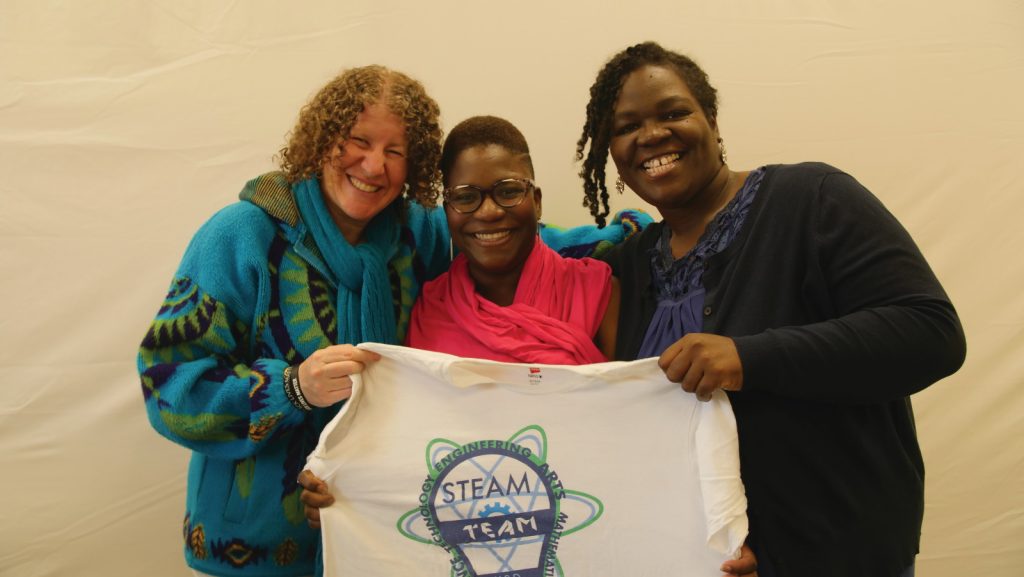 DR PERLA MYERS
DR PERLA MYERS
Professor, Department of Mathematics, Director of K-12 Community Engagement for the College of Arts and Sciences
DR ODESMA DALRYMPLE
Associate Professor, Industrial and Systems Engineering, Faculty Lead of the Engineering Exchange for Social Justice, Shiley-Marcos School of Engineering
DR JOI SPENCER
Interim Dean and Professor, Mathematics Education and Teacher Education, School of Leadership and Education Sciences
The University of San Diego, USA
FUNDERS: The University of San Diego Strategic Initiative Program and with donations from members of and organisations in the San Diego community
 DR PERLA MYERS
DR PERLA MYERSProfessor, Department of Mathematics, Director of K-12 Community Engagement for the College of Arts and Sciences
DR ODESMA DALRYMPLE
Associate Professor, Industrial and Systems Engineering, Faculty Lead of the Engineering Exchange for Social Justice, Shiley-Marcos School of Engineering
DR JOI SPENCER
Interim Dean and Professor, Mathematics Education and Teacher Education, School of Leadership and Education Sciences
The University of San Diego, USA
FUNDERS: The University of San Diego Strategic Initiative Program and with donations from members of and organisations in the San Diego community
WHY ARE ODESMA, JOI AND PERLA SO PASSIONATE ABOUT STEAM EDUCATION?
ODESMA
I was a typical child from a middle-class family – engaged in a lot of sports and extracurricular activities. I showed great strength in mathematics and science and was fortunate I demonstrated that interest early.
My dad was a teacher, and I will firmly say he was the best mathematician of all time! His ability to teach and contextualise mathematics, and to tell stories, was amazing. My dad taught me and my friends at home, and was also very active in his community, so I saw that example of being engaged. My mother worked in the government service. She didn’t like to see disadvantage and always got excited about solving problems. She was good at bringing in humour when working with people and I learnt from observing her.
By watching my parents, I saw how leadership, creative thinking and storytelling all tie in. For me, this led to engineering.
I’ve always been attracted to the fact that there’s never one answer to an engineering problem. There’s so much possibility to be explored, which means there can be individuality in approaching a problem. This complexity is exciting! Engineering is an opportunity for such intersection, in terms of the way we see problems and the way we approach them.
I like the human elements of engineering. It’s often seen as techno-centred, but I see it as a socio-technical endeavour. You have to see the social context in which people and problems exist in order to find a technical solution.
ODESMA’S TOP TIPS
01 Mix the liberal arts with scientific and mathematical subjects. Develop your critical thinking.
02 Remember, you have flexibility to make your engineering pathway individual to you. Link your engineering to your passions and interests.
03 The tool of social media and the ability to connect can help you to follow your curiosity and make connections with people. Ask, what am I curious about? The more you read, the more your world will open up. Seek out people and groups you’re interested in and say hello!
04 You don’t have to conform to stereotypes. Bring your culture and who you are into engineering.
JOI
As a child, I loved to read about science and animals. I was obsessed with the natural world. I also read about civil rights leaders like Malcom X, Martin Luther King and Fannie Lou Hamer. We didn’t learn about black history in my school, but I went to the library and read about it.
I grew up in South Central Los Angeles. People all around me were being brutalised by the police and some were dropping out of school. But I also had a counter-narrative – I had a family and their love in my life, so I was able to navigate it. If it wasn’t for my mother and my grandparents, I wouldn’t have had encyclopedias, I wouldn’t have gone to the library. I’ve also had some very inspirational teachers in my life.
I liked mathematics enough, however I felt that it lacked the depth of some other subjects. But when I started teaching it, straight after college, I saw how it helps us understand social phenomena. With my students, I looked at social issues like homelessness and patterns of wealth. For me, the value of mathematics is what it helps us to understand socially.
I love learning and I see education as a liberating tool. As a mathematics teacher, I want my students to see that all kinds of people can do mathematics and that it helps us to understand the society we live in.
Now that I train teachers, my reward is exponential. I can train one mathematics teacher who will go on to inspire thousands of young people. That is incredible!
JOI’S TOP TIPS
01 Don’t be afraid of mathematics, even if you haven’t done very well in mathematics courses. Keep exploring – the world of mathematics is vast.
02 Explore a lot of things, find what you love and pursue it.
03 If you’re a good reader, you can learn anything, in my opinion. To become a good reader, you’ve got to have something you’re interested in reading about!
04 History is really important and I would encourage young people to study it. My family exposed me to the history of black people from very early on and it helped me to understand the world I was experiencing. Wherever you are in the world, study history and it will unlock a lot of the challenges our world is facing.
PERLA
As a child, I would spend hours with music playing loudly while painting, drawing and building. I also loved to read any book that I could get my hands on and explore new worlds. My family played a lot of games and enjoyed solving puzzles. We also loved going on adventures. My mom would pile us into our Volkswagen bug and take us to visit factories to learn about the way they manufactured toothpaste or soft drinks or soap, or we would go to museums or parks. Cycling, roller skating, crafting, singing, cooking with my grandmother, playing with my friends… My childhood was very busy!
My calculus professor and undergraduate advisor at university ‘informed’ me that I would become a mathematician. He wrote a detailed plan of what classes I needed to take and which books I needed to read. I had no idea what a mathematician did or what the possibilities were, so I hadn’t considered it, but throughout my elementary, middle and high school I loved mathematics and was really excited to learn new concepts. I also learned the most while exploring mathematics with others and while I was helping my friends understand mathematical ideas. I loved finding ways to help them grasp the concepts and relished those awesome ‘Aha!’ moments.
What I find most challenging about my field is that there are so many people who have not had positive mathematics experiences, and for some, even hearing the word ‘mathematics’ causes anxiety. Many people see mathematics as just computation, or as a disconnected set of rules and regulations that they have to memorise and regurgitate. When they can’t recall all that information, they blame themselves and believe that they are just not ‘math people’ or that they don’t have ‘math brains’. That is not true.
What I find most rewarding is working, learning and creating with my colleagues and students, especially when we are finding ways to provide opportunities for others who may not have yet figured out that they are ‘mathematics people’ to explore mathematics, realise that mathematics is a beautiful, creative endeavour and that they are capable of asking questions, making discoveries and truly enjoying mathematics. I also have loved working with my colleagues in engineering and education to create experiences in STEAM.
Mathematics can be applied to every area. The more we know about other areas, from engineering and computer science, to architecture and political science, the better we can see how mathematics can help address the important challenges facing the world.
PERLA’S TOP TIPS
01 Learn as much as you can about many different areas and from everyone around you. This can lead to insightful problem-solving.
02 Ask lots of questions and be willing to make mistakes. Mistakes can evolve into new ideas.
03 Work hard and find ways to challenge yourself and engage in productive struggle – enhance your brainpower!
04 Believe in yourself, seek support and ask others for help.
05 Find time for self-care and to have fun!
Do you have a question for Odesma, Joi or Perla?
Write it in the comments box below and Odesma, Joi or Perla will get back to you. (Remember, researchers are very busy people, so you may have to wait a few days.)

